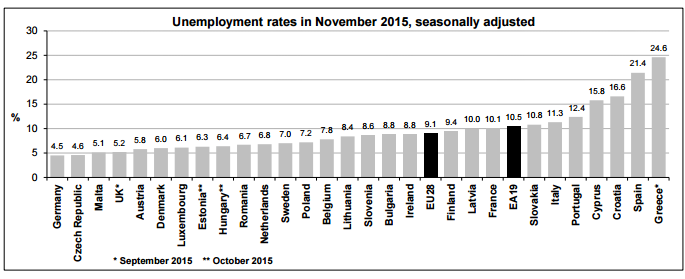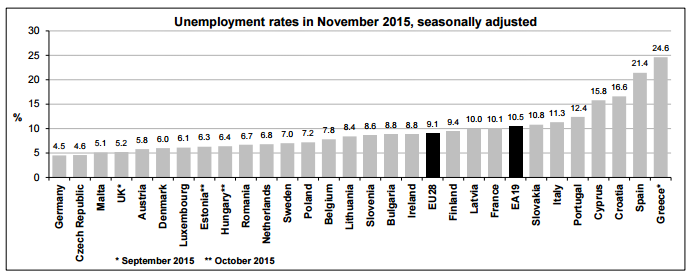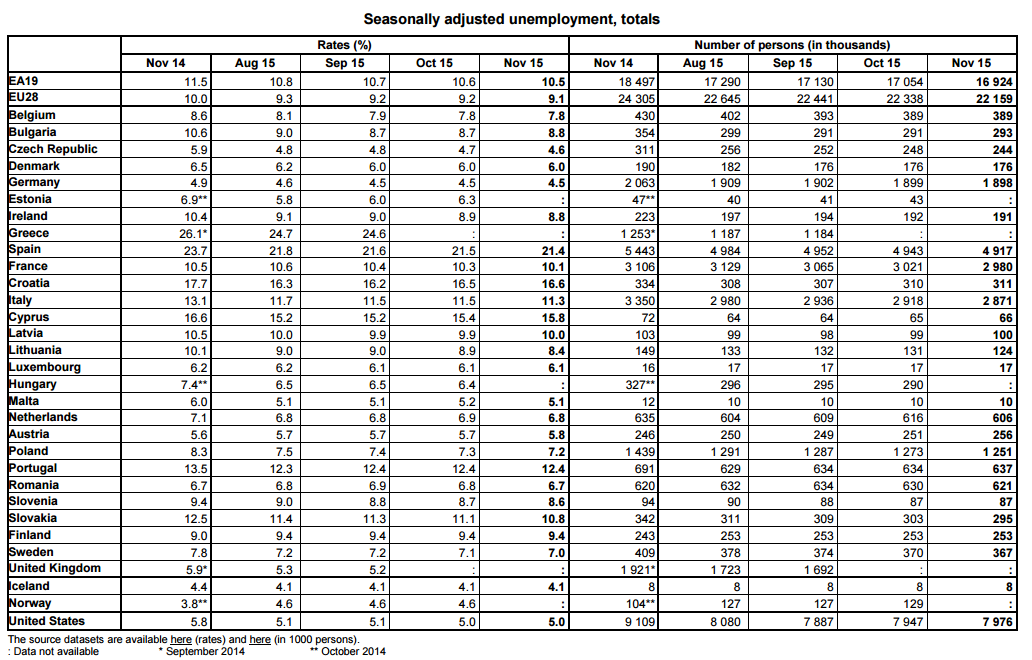Euro area unemployment rate at 10.5%

- EU28 at 9.1%
The euro area (EA19) seasonally-adjusted unemployment rate was 10.5% in November 2015, down from 10.6% in October 2015, and from 11.5% in November 2014. This is the lowest rate recorded in the euro area since October 2011. The EU28 unemployment rate was 9.1% in November 2015, down from 9.2% in October 2015, and from 10.0% in November 2014. This is the lowest rate recorded in the EU28 since July 2009. These figures are published by Eurostat, the statistical office of the European Union.
Eurostat estimates that 22.159 million men and women in the EU28, of whom 16.924 million were in the euro area, were unemployed in November 2015. Compared with October 2015, the number of persons unemployed decreased by 179 000 in the EU28 and by 130 000 in the euro area. Compared with November 2014, unemployment fell by 2.146 million in the EU28 and by 1.573 million in the euro area.
Member States
Among the Member States, the lowest unemployment rates in November 2015 were recorded in Germany (4.5%), the Czech Republic (4.6%) and Malta (5.1%), and the highest in Greece (24.6% in September 2015) and Spain (21.4%).
Compared with a year ago, the unemployment rate in November 2015 fell in twenty-five Member States, remained stable in Romania and increased in Austria (from 5.6% to 5.8%) and Finland (from 9.0% to 9.4%). The largest decreases were registered in Spain (from 23.7% to 21.4%), Bulgaria (from 10.6% to 8.8%) and Italy (from 13.1% to 11.3%).
In November 2015, the unemployment rate in the United States was 5.0%, stable compared to October 2015 and down from 5.8% in November 2014.
Youth unemployment
In November 2015, 4.553 million young persons (under 25) were unemployed in the EU28, of whom 3.167 million were in the euro area. Compared with November 2014, youth unemployment decreased by 412 000 in the EU28 and by 163 000 in the euro area. In November 2015, the youth unemployment rate was 20.0% in the EU28 and 22.5% in the euro area, compared with 21.5% and 23.2% respectively in November 2014. In November 2015, the lowest rates were observed in Germany (7.0%), Denmark (9.9%) and Austria (10.9%), and the highest in Greece (49.5% in September 2015), Spain (47.5%), Croatia (45.1% in the third quarter 2015) and Italy (38.1%).
Geographical coverage
The euro area (EA19) includes Belgium, Germany, Estonia, Ireland, Greece, Spain, France, Italy, Cyprus, Latvia, Lithuania, Luxembourg, Malta, the Netherlands, Austria, Portugal, Slovenia, Slovakia and Finland. The European Union (EU28) includes Belgium, Bulgaria, the Czech Republic, Denmark, Germany, Estonia, Ireland, Greece, Spain, France, Croatia, Italy, Cyprus, Latvia, Lithuania, Luxembourg, Hungary, Malta, the Netherlands, Austria, Poland, Portugal, Romania, Slovenia, Slovakia, Finland, Sweden and the United Kingdom.
Methods and definition
Eurostat produces harmonised unemployment rates for individual EU Member States, the euro area and the EU. These unemployment rates are based on the definition recommended by the International Labour Organisation (ILO). The measurement is based on a harmonised source, the European Union Labour Force Survey (LFS).
Based on the ILO definition, Eurostat defines unemployed persons as persons aged 15 to 74 who:
– are without work;
– are available to start work within the next two weeks;
– and have actively sought employment at some time during the previous four weeks.
The unemployment rate is the number of people unemployed as a percentage of the labour force.
The labour force is the total number of people employed plus unemployed. In this news release unemployment rates are based on employment and unemployment data covering persons aged 15 to 74.
The youth unemployment rate is the number of people aged 15 to 24 unemployed as a percentage of the labour force of the same age. Therefore, the youth unemployment rate should not be interpreted as the share of jobless people in the overall youth population.
Country notes:
Germany, the Netherlands, Austria, Finland, Sweden and Iceland: the trend component is used instead of the more volatile seasonally adjusted data.
Denmark, Estonia, Hungary, Portugal, the United Kingdom and Norway: 3-month moving averages of LFS data are used instead of pure monthly indicators.
*Click to enlarge
Source: europa – Euro area unemployment rate at 10.5%






























